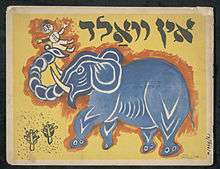Issachar Ber Ryback



Issachar Ber Ryback, also Riback (Іссахар-Бер Рибак; born 2 February 1897 in Yelisavetgrad, today Kirowohrad, Ukraine; died 22 December 1935 in Paris) was a Ukrainian-French painter.[2]
Life
Ryback visited the art school in Kiev until 1916. He joined a progressiv group of painters and was under the influence from advocates of a modern Jewish literature such as David Bergelson and David Hofstein. The painters Alexander Bogomazov and Alexandra Exter was in Kiev at the time and he was educated by them in 1913. In 1916 El Lissitzky and Ryback was given the task to make Jewish art memorials of Schtetls from Ukraine and Belarus. When he participated in an exhibition of Jewish paintings and sculptures in Moscow the spring 1917, his works was especially recommended.
During the October Revolution in 1917 he took part in multiple activities to redefine avantgarde Jiddish culture and therefore went to Moscow. After his father was killed by Petljuras soldiers in the Pogroms in Ukraine he fled in April 1921 to Kaunas and in October 1921 he obtained a visa for Germany. Until 1924 he was in Berlin. He was member of the Novembergruppe and exhibited his cubistic pictures at both the Berliner Secession and the Juryfreien Kunstausstellung. He also illustrated three small kiddish fairy tale books for Miriam Margolin. His Shtetl-litographies was published in 1923 by Schwellen-Verlag. At the time the Jewish education organization World ORT was situated in Berlin and he made the draft for its logo. In 1924 he tried again to work in the Soviet Union decorating scenes at Yiddish theaters.
In 1926 he emigrated to Paris and did not turn back to Russia. I 1928 he had a separate exhibition in the „Galerie aux Quatre Chemins“ and in 1929 in the „Galerie L’Art Contemporain“. His style of painting had turned to the expressionistic colouring of the School of Paris in the interwar period. Further exhibitions followed at galleries in The Hague, Rotterdam, Brüssel and Antwerpen. In 1935 he travelled to the opening of his exhibition in Cambridge. He did not live to see the retrospective exhibition in Paris arranged by Georges Wildenstein.
Rybak was contemporary of the Jewish-Russian artists Natan Issajewitsch Altman, Boris Aronson and Marc Chagall who worked with handing down the Jewish tradion in modern art. Most of the works he left behind is in Museum Ryback in Bat Yam in Israel.
Publications (selection)
- Ausstellung. J. Ryback. Buch u. Kunstdruckerei Lutze und Vogt, Berlin 1923.
- A l'ombre du passe. Les Editions Graphiques, Paris 1932.
- Leib Kwitko: In Vald ("Im Wald"), Zeichnungen von Issachar Ryback, Schwellen Verlag, Berlin 1922. In Jiddisch und in deutscher Übersetzung enthalten in: David Bergelson, Lejb Kwitko, Peretz Markisch, Ber Smoliar: Der Galaganer Hahn : jiddische Kinderbücher aus Berlin ; jiddisch und deutsch, Aus d. Jidd. übertr. und hrsg. von Andrej Jendrusch, Berlin : Ed. DODO , 2003 ISBN 3-934351-06-9
- Leib Kwitko: Voigelen ("Vögel"), Zeichnungen von Issachar Ryback, Schwellen Verlag, Berlin 1922. In Jiddisch und in deutscher Übersetzung enthalten in: David Bergelson, Lejb Kwitko, Peretz Markisch, Ber Smoliar: Der Galaganer Hahn : jiddische Kinderbücher aus Berlin ; jiddisch und deutsch, Aus d. Jidd. übertr. und hrsg. von Andrej Jendrusch, Berlin : Ed. DODO , 2003 ISBN 3-934351-06-9
Literature
- Salomon Wininger: Große jüdische National-Biographie. Kraus Reprint, Nendeln 1979, ISBN 3-262-01204-1 (Nachdr. d. Ausg. Czernowitz 1925). Band 5, S. 189
- Issesokher Ber Ribak : zayn lebn un shafn. Funm Komitet tsu fareybikn dem ondek fun Issesokher Ber Ribak, Paris 1937
- Zalmen Reyzen: Ryback Issakhar Ber. In: Lexikon fun der yiddisher literatur, presse un filologie. Band 4, Farlag fun B. Kletskin, Wilna 1929, S. 316–320
- Raymond Cogniat: I. Ryback. Ėditions L’Amitié Française, Paris 1934.
- Karl Schwarz: Jewish Artists of the 19h and 20h Centuries. New York 1949, S. 203–207
- Mané-Katz – Issachar Ryback: Connections. Mané-Katz Museum, Spring 1993. Haifa, 1993.[3]
- KULTUR-LIGE Artistic Avant-Garde of the 1910's and the 1920's. 20. Dezember 2007 – 20. Januar 2008, Nationales Kunstmuseum der Ukraine
External links
| Wikimedia Commons has media related to Issachar Ber Ryback. |
- Literature by and about Issachar Ber Ryback in the German National Library catalogue
- Issachar Ber Ryback bei aatc
- Issachar Ber Ryback bei Comité & Foundation Issachar Ber Ryback
- Seth L. Wolitz: Rybak, Yisakhar Ber, Kurzbio bei YIVO Encyclopedia (en)
References
- ↑ Die Wiedergabe des Buchtitels folgt der bei WorldCat angegebenen Transkription
- ↑ Vita nach den Angaben bei Comité & Foundation Issachar Ber Ryback
- ↑ Emmanuel Mané-Katz siehe englischsprachige Wikipedia en:Mane-Katz
